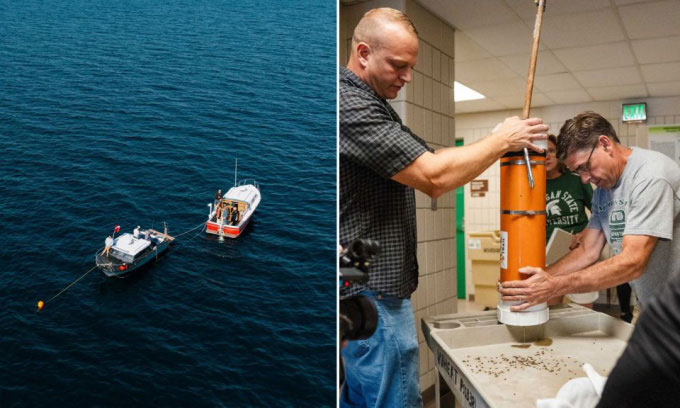Barley grains revived from 145-year-old shipwreck to make wine
Experts collect rye seeds from a shipwreck under Lake Huron to revive the lost plant and plan to make whiskey.
In 1878, the James R. Bentley, a schooner, sank in Lake Huron , one of North America's Great Lakes, while carrying rye to Chicago. The crew survived the accident, but the cargo—a now extinct variety of rye—was lost beneath the water. The wreck remained hidden for more than a century until it was discovered in 1984.

Eric Olson's team collects rye seeds. (Photo: Michigan State University).
On September 17, 2024, a team of scientists used special metal tubes to collect submerged rye grains. They retrieved a significant amount, but keeping them alive was a major challenge. Exposure to oxygen and warmer temperatures could damage the grains after long periods underwater.
The newly collected seeds, called Bentley's rye after the shipwreck, were quickly sent to Michigan State University (MSU) for analysis. Associate professor Eric Olson, an expert in wheat genetics and breeding, expressed caution about the possibility of germination. "The idea of the seeds germinating is interesting, but it's very difficult because they've been underwater for 145 years , " Olson told Interesting Engineering on November 21.
Despite appearing intact, the original seeds failed to germinate even with the help of gibberellic acid, a plant hormone used to induce dormancy in seeds. 'Although they looked fine, it's possible that the seeds no longer had the functional mitochondria needed for germination ,' Olson explains.
But the team found an alternative: extracting genetic material from the seeds to recreate their historical traits . "We can resurrect the genes in the seeds and use modern genetic sequencing techniques to assemble parts of the genome. We'll sequence the chromosomes of this rye and transfer those chromosome segments into a modern rye, essentially resurrecting the historical rye ," Olson said.
The team plans to combine the genetic material of Bentley barley with another historic variety, Rosen rye. This will create a new crop. The hybrid crop could be used to make whiskey, connecting Michigan's agricultural history with its present economy.
'If we successfully introduce the rye chromosome fragments from the Bentley wreck into Rosen rye, it will attract tourists and create many opportunities for farmers ,' Olson shared.
- Discovered wreck carrying 6,000 jars of ancient wine
- Discovering the ancient tombs of the women
- Hidden beauty of sand
- Discovered a thousand-year-old wine in China
- Discovered 900 bottles of hundred-year-old wine on the bottom of the sea
- Why should wine storage be kept horizontally not to stand?
- Three types of healthy, home-made, healthy, healthy wines
- Teapot 2,000 years in the tomb of the Qin Dynasty in China
- Eco-friendly barley
- New discovery about the ancient origin of grape wine
- Why shouldn't you drink wine with ice?
- Discovering a 2,000-year-old remains in a shipwreck in the Mediterranean
 Discovered an ancient centipede fossil 99 million years old
Discovered an ancient centipede fossil 99 million years old Discovered bat-like dinosaurs in China
Discovered bat-like dinosaurs in China Discovered a 200-year-old bronze cannon of the coast
Discovered a 200-year-old bronze cannon of the coast Discover 305 million-year-old spider fossils
Discover 305 million-year-old spider fossils